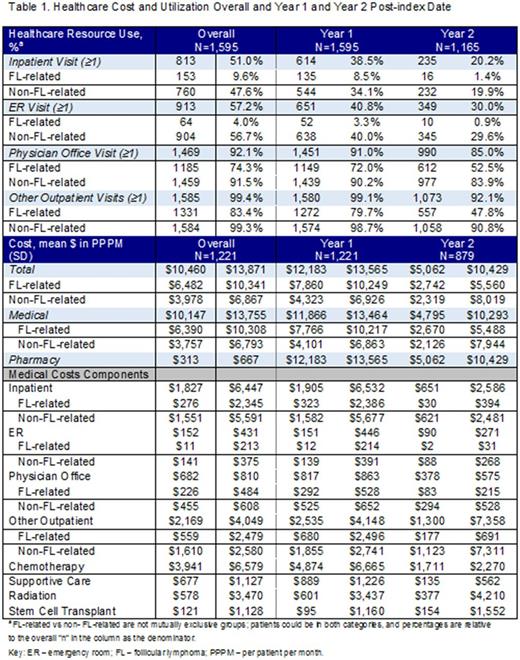Abstract
Background: Healthcare burden of FL has not been extensively studied in the US. We evaluated healthcare utilization (HCU) and costs for FL patients receiving routine clinical care in the US.
Methods: Adult patients newly diagnosed with FL were identified from the Optum claims database (01/01/08 - 10/31/15). The first FL claim was the index date. Patients who initiated FL treatment were followed from index date until end of continuous enrollment, death, end of study period (12/31/15), or transition to diffuse large b-cell lymphomafor the assessment of FL- and non-FL-related HCU and costs. FL-related HCU and costs were medical claims with a primary diagnosis of FL or FL treatment (ie, chemotherapy, radiation, stem cell transplant, and supportive care) and pharmacy claims for FL treatment. The proportion of patients with HCU was reported, and costs were calculated as per-patient-per-month (PPPM) costs and reported as mean (standard deviation [SD]). Patients with a capitated payment plan were excluded from the cost analysis.
Results: 1,595 treated FL patients were identified. Over the follow-up, 51.0% of patients had an inpatient admission, 57.2% had an emergency room visit, 92.1% had a physician office visit, and 99.4% had other outpatient visits (Table 1). HCU decreased from Year 1 to Year 2 of the diagnosis. The mean PPPM total costs incurred during the follow-up period was $10,460 (SD: $13,871); costs were higher in Year 1 ($12,183, SD: $13,565), but decreased drastically in Year 2 ($5,062, SD: $10,429). 61% of overall costs were for FL medical services ($6,390 PPPM, SD: $10,308), which decreased from Year 1 ($7,766, SD: $10,217) to Year 2 ($2,670 PPPM, SD: $5,488). This decrease was driven by decreased chemotherapy and supportive care medical services and other outpatient medical services. Non-FL-related medical costs accounted for 36% of the overall PPPM costs ($3,757, SD: $6,793); again, a decrease was noted from Year 1 ($4,101, SD: $6,863) to Year 2 ($2,126, SD: $7,944). A reduction in inpatient admissions was the main driver in this decrease.
Conclusions: Economic burden of treated FL patients is high, with the majority of costs incurred during the first year. Costs decreased in the second year, mainly due to decrease in treatment costs. HCU for FL-related services also decreased in the second year after FL diagnosis.
Galaznik: Takeda Pharmaceuticals: Employment, Equity Ownership. Bell: Takeda Pharmaceuticals: Employment, Equity Ownership. Hamilton: Xcenda: Employment; Millennium Pharmaceuticals, Inc., a wholly owned subsidiary of Takeda Pharmaceutical Company Limited: Consultancy. Ogbonnaya: Xcenda: Employment; Millennium Pharmaceuticals, Inc., a wholly owned subsidiary of Takeda Pharmaceutical Company Limited: Consultancy. Hennenfent: Xcenda: Employment; Millennium Pharmaceuticals, Inc., a wholly owned subsidiary of Takeda Pharmaceutical Company Limited: Consultancy. Eaddy: Millennium Pharmaceuticals, Inc., a wholly owned subsidiary of Takeda Pharmaceutical Company Limited: Consultancy; Xcenda: Employment. Shou: Takeda Pharmaceuticals: Employment, Equity Ownership.
Author notes
Asterisk with author names denotes non-ASH members.


This feature is available to Subscribers Only
Sign In or Create an Account Close Modal